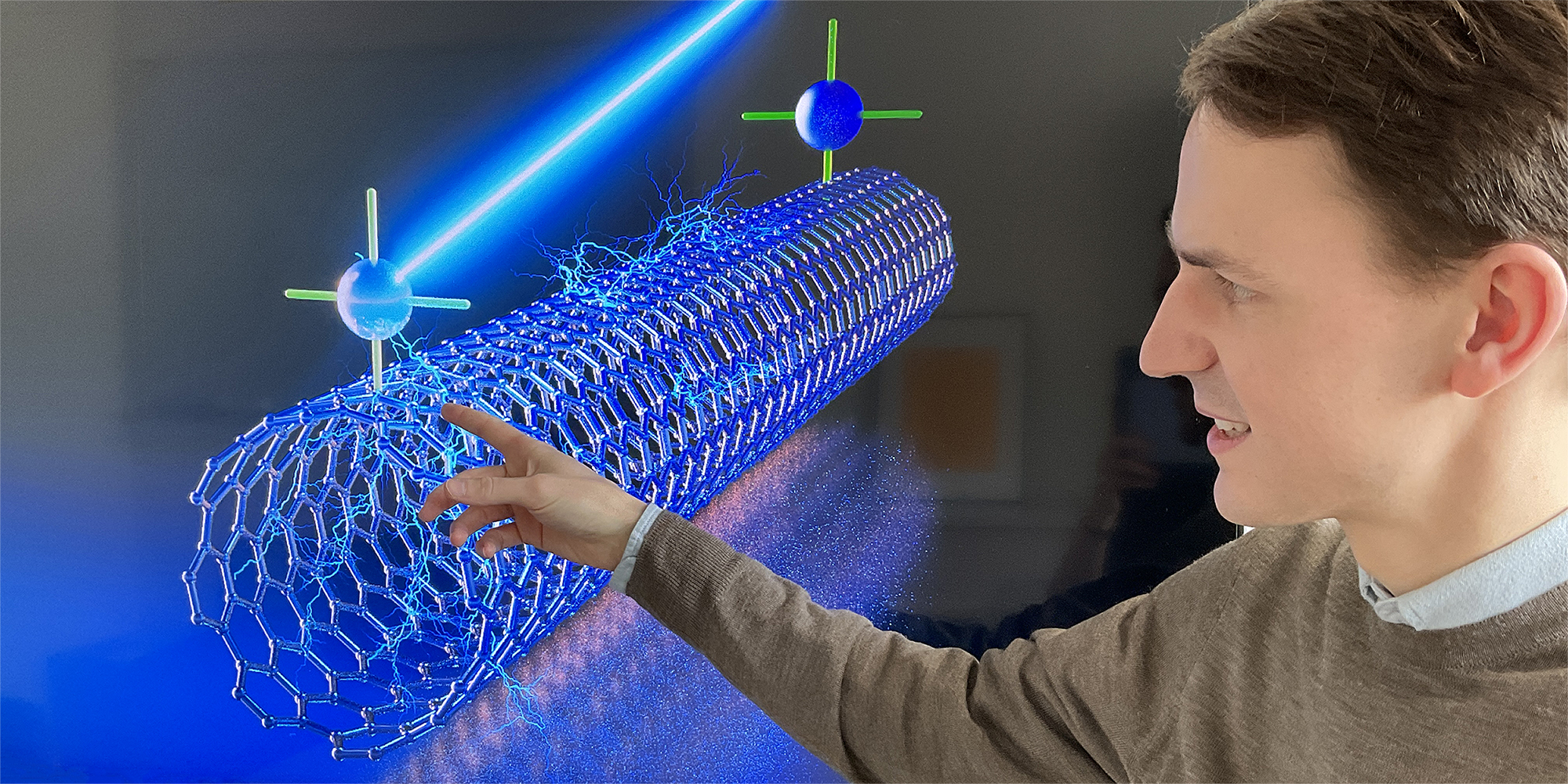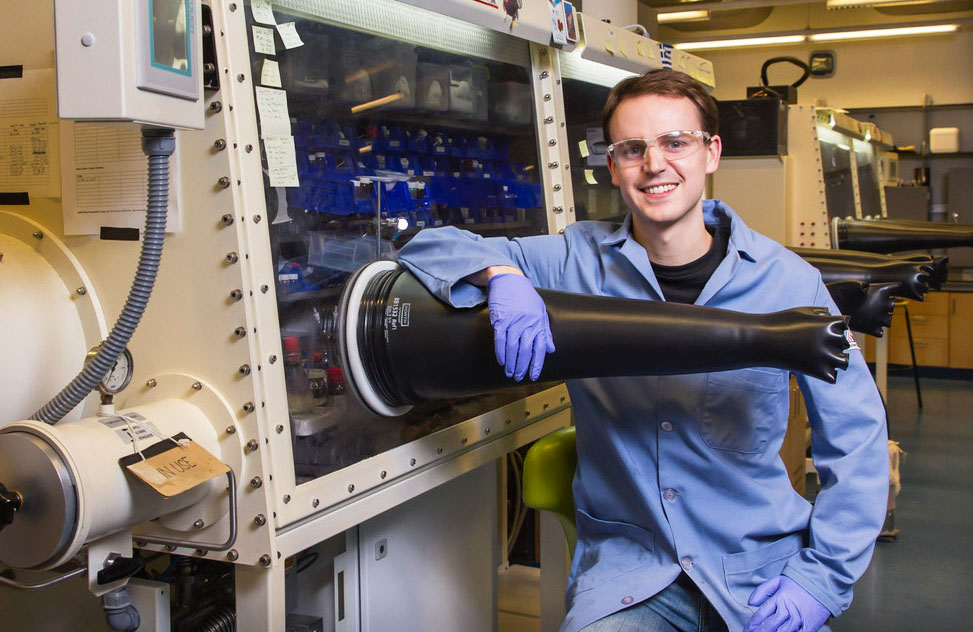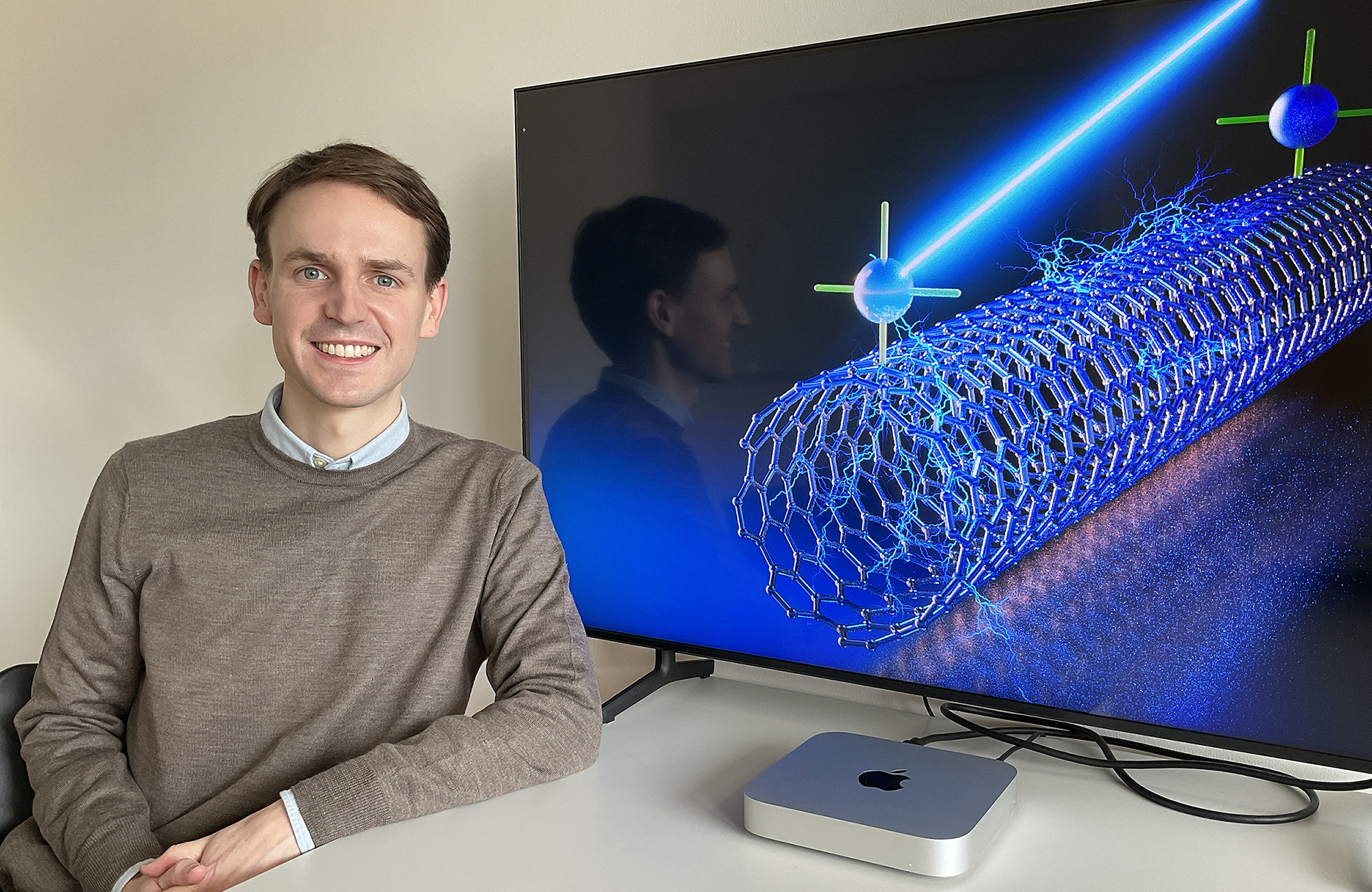
Building chemical sensors to combat climate crisis
The therapy our ailing planet needs is a major change in energy and agricultural practices, and improved monitoring. Máté Bezdek, formerly a researcher at MIT and now an assistant professor at the LAC / D-CHAB, is addressing these global challenges with molecular, sustainable solutions. In an interview, he talks about how to capture in real time what has remained hidden so far, why one should be able to explain complex research in three minutes, and what makes Switzerland a superpragmatic place.
A pair of carefully placed sneakers stands near the front door, an impressively large monitor on the conference table, and a few boxes full of equipment in the back corner of the office. They are subtle hints about the young man who has moved into this office in HCI: an inorganic chemist who still works in the lab in sneakers and wants to be a role model for his team; someone who likes to exchange ideas at the meeting table and who has traveled far for his goals. Last year, Máté Bezdek moved to Switzerland from the US with his wife. He swapped the concrete walls of the Massachusetts Institute of Technology (MIT) for those of ETH Zurich to take up the professorship of Functional Coordination Chemistry, and to make a difference: as a teacher for his students and as a researcher for society.

The power of chemistry
"Part of what appealed to me about chemistry is that it is applied. In the 21st century, we have to figure out a way to support our increasing population and the associated food and energy demands, without destroying the planet," Máté Bezdek emphasizes. "There has to be a major energy shift and a major shift also in things like our agricultural practices. Many of these problems are molecular problems at their core. Luckily as chemists we are experts in the molecular sciences and can contribute significantly to the solution."
Máté Bezdek got the tools for this at some of the best universities in the world. Originally from Budapest, Hungary, he moved as a child with his family to Canada, near the Rocky Mountains. "Probably one reason why I still love nature and hiking so much," Bezdek adds with a smile. After earning a bachelor's degree in chemistry at the University of Calgary, he went to Princeton, in the USA. Early on, he was particularly interested in inorganic synthesis, especially in the field of coordination chemistry. "Coordination compounds consist of one or more central atom plus surrounding fragments we call “ligands” that combine to form beautiful geometric shapes. Typically, they contain transition metals at their core. Their properties are highly tunable for various applications using the tools of chemical synthesis," Bezdek explains enthusiastically.
“"Almost everything that surrounds us has been made in a process that contains transition metals or has been catalyzed by a transition metal. In an iPhone, for instance, there are over 60 different ones."”Prof. Máté Bezdek

How to build chemical "sensory organs"
At Princeton, Bezdek investigated what catalysts would be needed to enable ammonia to be used as a CO2-neutral fuel or as a source of hydrogen gas – important fundamentals, but still some ways from being applied. At MIT, in Tim Swager's highly motivated team, he eventually found a project closer to the realm of applications. "I was working on methane sensors," Bezdek explains, "Methane is 100 times more potent than CO2 as a greenhouse gas. When natural gas is transported, methane enters the atmosphere at alarmingly high levels through leaks in the pipeline, but so far it cannot be effectively detected. My work has been to develop a methane sensor that is cheap and robust enough so that it can be distributed around the globe and can provide real-time information about leaks that should be repaired."

At ETH, Máté Bezdek would like to continue developing such sensors, also called chemiresistors, although to detect other environmental pollutants besides methane. Chemiresistors are based on the interaction between the selector – a molecule on the surface of the sensor – and the analyte, the substance that is to be detected, for example a gas. To do that, the chemical interaction must first be translated into something measurable, such as resistance. "A change in resistance usually indicates that a chemical reaction has taken place, which means the sensor worked," Bezdek explains. If it is the right reaction, however, depends on the selectivity of the sensor: "The reaction should only undergo with the desired substance. That's difficult with environmental samples, which also contain CO2 or water vapor, for example. The sensor has to be selective enough to detect the desired substance against a very complex background."
To increase the selectivity of the sensors, Máté Bezdek and his group are also investigating carbon-transition metal hybrids: carbon nanotubes that are "fused" with optimized transition metals. "The carbon nanotubes consist of a single rolled-up graphite layer and have special properties," Bezdek explains, "they are very robust and can act as semiconductors. They are interesting for sensors because they can be used to make devices with extremely low power requirements." That's an important aspect, because the sensors will be used in the field, where they need a continuous supply of energy for monitoring. "So the tubes provide the energy-saving platform, but for selectivity, we need to link optimized transition metals to the tube."

However, the hybridization step and the required characterization of the carbon tube surface is not easy. "If we succeed, then in the future carbon-transition metal hybrids could be used worldwide as energy-efficient, specific sensors – on the one hand to find and monitor environmental pollutants such as nitrogen oxydes, and on the other to detect small molecules that can be used to diagnose human diseases," Bezdek explains. Furthermore, an application in battery technology would be possible. For now, however, he and his group are focusing on sensor technology.
Science Slams as challenge and exercise
"Besides research, I also enjoy teaching. My goal is to build a lab where students can learn a wide range of techniques and applications." Currently, Máté Bezdek‘s group has two graduate students, but the team is expected to grow soon. At MIT, Bezdek has experienced firsthand how enriching a diverse group can be: "Whenever I needed something, my teammates were on hand, and they came from different disciplines and backgrounds. This was a very beneficial, desirable model. Today's problems are just too complex to be solved from one perspective."
Bezdek also strives for a good exchange with the public. As science slam winner at MIT (see video), he has already demonstrated a talent for this. He successfully packed his research into three minutes and could convince the audience as well as the expert jury. "Immediately, you start using technical terms and suddenly you realize: wait a minute, no one knows what I'm talking about, right? So, it's a cool challenge. Apart from that, I also see this as an important exercise for us researchers. People trust that we can solve the problems of our time. We have a responsibility and owe it to the public to find understandable words for our work – of course without overselling our results."
Switzerland seems to be the right spot for all these projects. An "amazing and superpragmatic place," Bezdek says with a laugh, where people approach many things rationally and thoughtfully, and where there is plenty of inspiration. The best ideas often come from outside the laboratory, for example on weekends in the lofty heights of Switzerland, where one can go hiking and take a break from the challenges of the 21st century, at least for a little while.
